I won’t mince words. Last November’s election for US president hit Deb and me like a punch in the gut. In fact, we’re still reeling from what seems like a daily assault on what we have always held as true; we have the unalienable rights of life, liberty, and the pursuit of happiness. We’ve never shied away from “provocative” topics in our art, so we knew we would eventually protest this unjust administration. However, we felt paralyzed for a time, completely incapable of understanding how anyone, regardless of party affiliation, could have voted for someone who clearly had no respect for women, immigrants, or the US Constitution. Thankfully, ten artists* formed an alliance to mount a juried exhibition “to protest the Trump administration’s actions and policies.” It was the inspiration we needed to give voice to our despair. Our submission was accepted, and we are proud to say we are part of “Threads of Resistance.”
Deciding on a theme for the piece was at first glance somewhat difficult. There had been so much bluster, banter, and so many outright lies that it was hard to pinpoint one thing above the others to concentrate on. In the end, though, we kept coming back to the topic of the so-called “Muslim ban.” We weren’t the only ones who felt this proposed ban was not only morally wrong but also unconstitutional. Americans came out in droves on January 29, 2017, to protest the president’s Executive Order 13769. (Click here to read more about these protests.) This order was eventually replaced by Executive Order 13780.
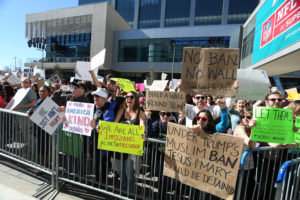
Unlike the president, we are students of history and kept seeing the parallels between his proposed “Muslim ban” and the wholesale incarceration of 120,000 Japanese Americans during WWII. February 19, 2017 marked the 75th anniversary of the signing of Executive Order 9066, which paved the way for the imprisonment of Japanese Americans in ten concentration camps within the United States. I kept thinking about my family, who ended up in what became known as the Tule Lake Segregation Center.
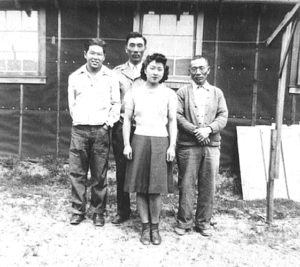
Jichan (Grandpa) Sazaki in Tule Lake
What had they done to deserve this? Absolutely nothing. Deb and I know there are many Muslim Americans who might suffer the same fate as my family did, so we looked for a way to express this notion. Around this time I went to an exhibition about the Japanese American community in Sacramento, California, and I happened upon a photograph of Mitsuye Endo, whose case to invalidate her incarceration made its way to the US Supreme Court. Deb and I admired her courage, fortitude, and resistance. You can read more about her story at densho.org, which “preserves, educates, and shares the story of World War II-era incarceration of Japanese Americans in order to deepen understandings of American history and inspire action for equity.”
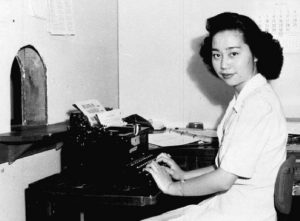
As soon as we saw the entire photograph, we knew we had to do Mitsuye Endo’s portrait. In this photo, she looked like a typical American secretary . . . except she wasn’t white. We were delighted to find out that the owner of the copyright of this photo was none other than our own alma mater, California State University, Sacramento, so it was easy to get permission to use it in our project. Collaging the portrait was relatively easy, too, because we had many good words and phrases to choose from the current news and the anniversary of Executive Order 9066. The one thing we had to debate was whether or not to use blue as the shading color on Endo’s face. In Japanese art, the color blue is often used on faces to depict ghosts or the dying. We finally decided that we wanted Endo to represent the death of the American dream, so the color befitted our intent.
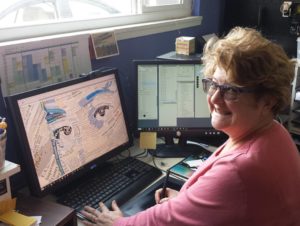
The last component of our piece was the background. Should we make it out of words and phrases like we did the face, or should we make it more subtle in order to bring Endo’s face into sharper focus? We kept talking about how Japanese Americans and Muslim Americans were singled out because of their looks, religion, or some other arbitrary marker to the point where we said, “Yeah, what does an American look like?” So that was how the background was born, but we didn’t stop there. Since we have many friends who speak other languages, we decided to ask them how to say “What does an American look like?” in other languages. This simple question begged further questions like “Do you mean physical traits?” “Do you mean what do they think like?” “Do you mean how do they act?” It turned out to be a compelling question. Here is the finished piece:
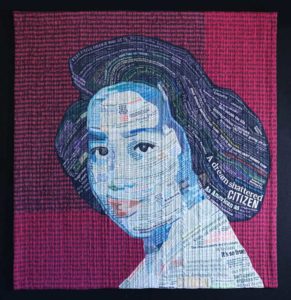
Let us take this opportunity to publicly thank the following people for providing the translations. Be they academics, immigrants, artists, or business owners, they are above all our friends:
Arabic – Shahzad B.
Chinese – Clauda R. and Ellen W.
Dutch – Els M.
French – Eric F.
German – (Kris and Deb, of course!)
Italian – Susan A.
Japanese – Mario E.
Malagasy – Bakoly R.
Romanian – Danny M. and Paul B.
Russian – Amy A.
Spanish – Deborah F.
Here is the artist statement we submitted for the exhibition:
In 1942, President Roosevelt signed Executive Order 9066, which resulted in the incarceration of Mitsuye Endo and 120,000 other Americans of Japanese ancestry. She became a plaintiff in a lawsuit filed by the ACLU to strike down her incarceration as unconstitutional. Despite governmental offers of an early release, Endo remained in camp in order for the case to make it to the US Supreme Court. Her victory led to the release of the prisoners in 1945. Fast forward to 2017 when we have witnessed President Trump sign first Executive Order 13769 and then Executive Order 13780, “Protecting the Nation from Foreign Terrorist Entry into the United States.” Both orders have been stopped by lower courts, so this “Muslim Ban” has yet to be implemented. This case is making its way to the Supreme Court. [Update: The US Supreme Court has agreed to hear the case in the fall of 2017 and has temporarily reinstated part of the ban. Click here to read more about this decision.]
These executive orders may be separated by 75 years but rely on the same fears of “the enemy.” That is why we pose the question, “What does an American look like?” Mitsuye Endo was an American. She was born in Sacramento, California, graduated from high school, and went to work for the California state government until she was fired from her job and incarcerated. So as you look around the room today, can you tell us what an American looks like?
* Our heartfelt gratitude to the Artist Circle Alliance members, who found the courage to resist: Sue Bleiweiss, Susan Brubaker Knapp, Judy Coates-Perez, Jane Dunnewold, Victoria Findlay Wolfe, Jamie Fingal, Lyric Montgomery Kinard, Melanie Testa, Leslie Tucker Jenison, and Kathy York
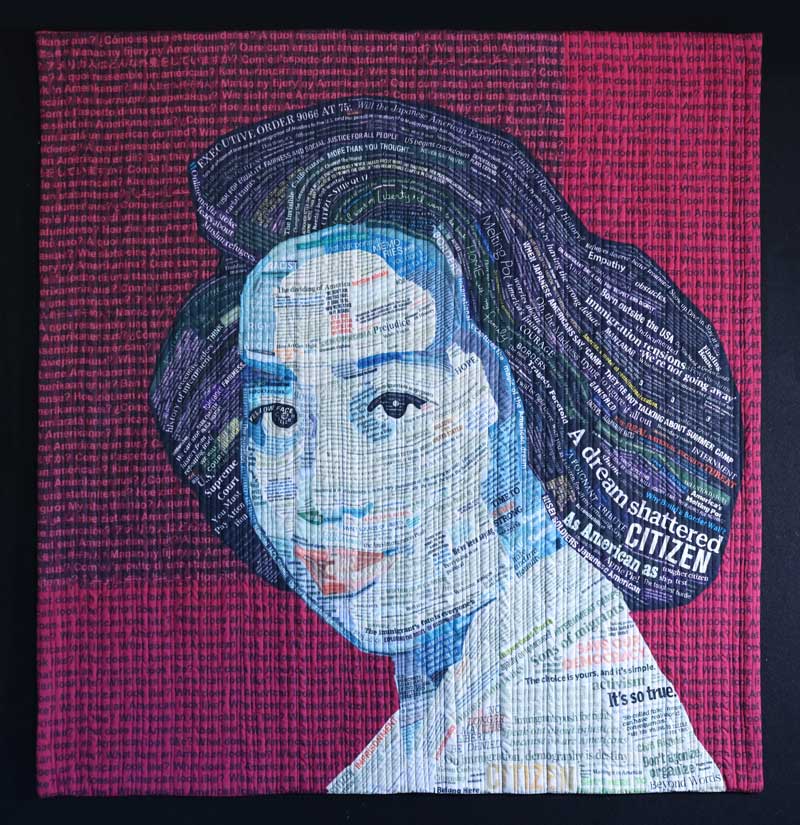

4 responses to “Art And Politics: What Does An American Look Like?”
Thank you for your story, research and description of the decisions you made in creating this powerful work.
An awesome piece. Certainly we live in troubling times and I am thankful that I am Canadian but I do feel for my American neighbours.
Thank you for this wonderful art quilt piece, calling attention to both executive orders- and the bravery of Ms.Endo. So proud of you both and happy to know we are friends!
This piece is an excellent reminder of the history we must never forget. I’m looking forward to seeing the exhibit in Lowell, MA.